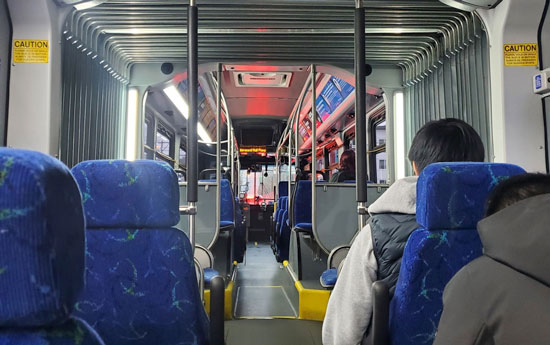The Lynnwood Link light rail is currently being built from Northgate Station to four stations in Snohomish County. The four stations will open in 2024, with two in Shoreline, one in Mountlake Terrace and one in Lynnwood.
Faith Noh
SNOHOMISH COUNTY — In advance of Sound Transit light rail reaching Snohomish County in 2024, Community Transit is asking residents to help redesign the local bus service.
Feedback is currently being accepted through Dec. 17 in an online survey that is available in five languages: English, Spanish, Korean, Chinese and Russian. Visit www.communitytransit.org to reach the survey.
Because light rail will replace buses going to Northgate and downtown Seattle in 2024, Community Transit is mainly looking for public feedback on creating new bus routes and increasing bus frequency on existing routes in the county.
Through community engagement, the agency’s main goals are connecting buses to light rail, expanding access to frequent bus service, adjusting to the changing market of how people ride buses and focusing on equitable access. Overall, the agency pledges to make travel easy for all.
“A focus on equitable access is really key to all of this work,” Luke Distelhorst said during an online open house on Dec. 1. He is the public information specialist for Community Transit. “Most transit agencies work under Title VI, which are federal guidelines against discrimination. We’re going above and beyond that with this work.”
“We’re using a new equity index in how we evaluate our services,” Distelhorst said. “This takes into account populations living at or below 200% of the Federal Poverty Line, which is currently defined as about $35,000 for a household of two. We’re looking at populations that are foreign-born, communities of color and Latinx populations, households that might have limited English proficiency, as well as populations living with a disability.”
“These are all things that are not covered under Title VI, but we feel are really important in how we are designing our future transit services,” Distelhorst said.
From this viewpoint, Community Transit aims to not only improve access to public transportation in areas and communities that have been underserved in the past, but also prioritize these communities in the feedback and planning process.
“The train and (bus route) 512 basically run so often that I don’t have to check a schedule and I just hop on,” Chloe , a local rider, said. “But by the time I get to Ash Way Park & Ride after work, (bus route) 119 only runs once an hour and I end up stranded five minutes from my home for over 30 minutes sometimes.”
Chloe is one of many local riders looking forward to increased bus frequency for local routes.
On the other hand, some have shared feedback on issues that are not addressed in the survey.
“A key element in this future would be to allow kids to ride free,” said Deborah Kilgore, who is on the school board for the Edmonds School District. “Since kids and youth ride free in other cities and states around the country, other benefits are
well-documented, including more disposable income
for families, increased freedom and mobility for students, as well as decreased traffic and congestion.”
Furthermore, Kilgore noted that the majority of Community Transit’s revenues actually come from sales tax and federal grants while bus fares make up less than 5% of revenues. ≈As a result, she also wants the agency to have a discussion on having free fares for all.
“Fares are gatekeepers, to reduce the ‘riff-raff’ and also to encourage riders to value their trip and not take it for granted or mistreat the bus they’re riding in,” Kilgore said. “Are fares necessary or are there other ways we can get the same positive outcomes? There’s this whole infrastructure built around collecting fares, and all those resources might be redirected toward more community-building purposes.”
Even though the survey does not cover the issue of bus fares, Kilgore encourages others to fill it out anyway and remains optimistic for new changes in the future.
“Transportation has to be one of the biggest impediments to equitable access in our district, in my opinion,” Kilgore said. “The entire community can benefit in ways that we’ve just begun to talk about, and more ways we haven’t even thought of yet.”
The survey was released on Nov. 15 and will be open until Dec. 17. The survey consists of 21 questions and takes roughly five minutes to complete.
To ensure that the survey is reaching a representative audience of Snohomish County residents, Community Transit has been hosting a variety of outreach events, such as handing out flyers at bus stops and organizing online open house virtual tours.
After receiving public feedback, Community Transit plans to incorporate the feedback in designing a draft network over the next few months. This draft will be released to the public in the spring, where residents will again be invited to
comment and provide more in-depth feedback on the new draft.
“It will probably be a very similar process to what we’re doing right now,” Distelhorst said. “But it will probably be longer and more detailed.”
Finally, after taking more public feedback, the agency will create the final draft network that will be sent to the board of directors for approval in the fall 2022.
 Faith Noh photo
Faith Noh photo